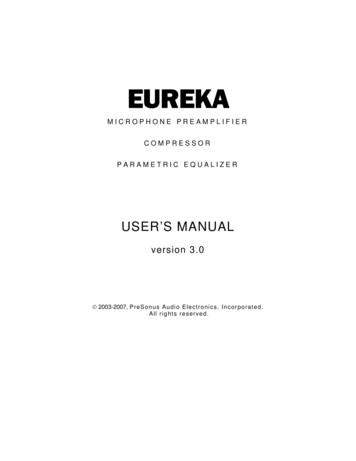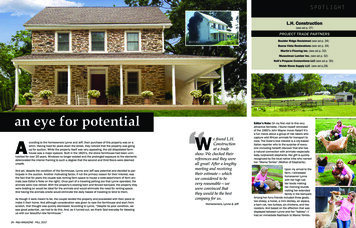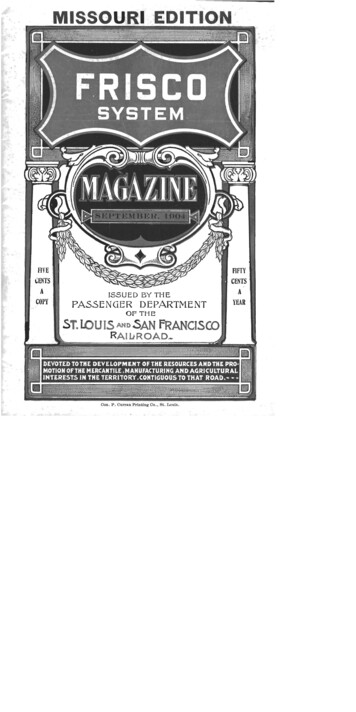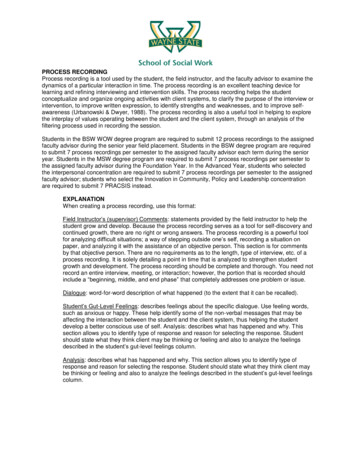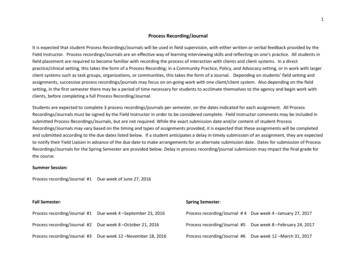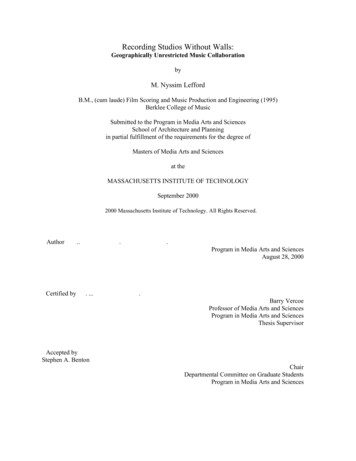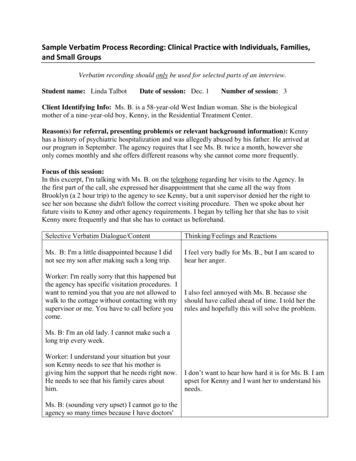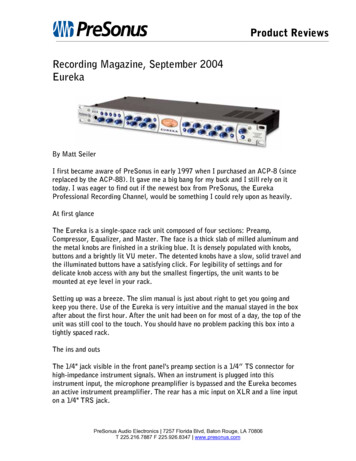
Transcription
Product ReviewsRecording Magazine, September 2004EurekaBy Matt SeilerI first became aware of PreSonus in early 1997 when I purchased an ACP-8 (sincereplaced by the ACP-88). It gave me a big bang for my buck and I still rely on ittoday. I was eager to find out if the newest box from PreSonus, the EurekaProfessional Recording Channel, would be something I could rely upon as heavily.At first glanceThe Eureka is a single-space rack unit composed of four sections: Preamp,Compressor, Equalizer, and Master. The face is a thick slab of milled aluminum andthe metal knobs are finished in a striking blue. It is densely populated with knobs,buttons and a brightly lit VU meter. The detented knobs have a slow, solid travel andthe illuminated buttons have a satisfying click. For legibility of settings and fordelicate knob access with any but the smallest fingertips, the unit wants to bemounted at eye level in your rack.Setting up was a breeze. The slim manual is just about right to get you going andkeep you there. Use of the Eureka is very intuitive and the manual stayed in the boxafter about the first hour. After the unit had been on for most of a day, the top of theunit was still cool to the touch. You should have no problem packing this box into atightly spaced rack.The ins and outsThe 1/4" jack visible in the front panel's preamp section is a 1/4” TS connector forhigh-impedance instrument signals. When an instrument is plugged into thisinstrument input, the microphone preamplifier is bypassed and the Eureka becomesan active instrument preamplifier. The rear has a mic input on XLR and a line inputon a 1/4" TRS jack.PreSonus Audio Electronics 7257 Florida Blvd, Baton Rouge, LA 70806T 225.216.7887 F 225.926.8347 www.presonus.com
Product ReviewsThe Line button in front selects the line input on the back as the input in use. Whenthe Line input is in use, the microphone preamplifier stage is bypassed and thus theGain, Impedance and Saturate controls are inactive.The rear panel has dedicated send and return jacks for inserting things like reverbsinto the signal chain. Output is carried via balanced 1/4” TRS and XLR connections,both of which are active at all times. Wall voltage is handled via IEC cable and thereis a power switch on the rear panel.The mic preampOn the front left are the controls for the class A transformer-coupled mic preamp thatdoubles as instrument preamp and line input. Pushbuttons allow for 48 volts ofphantom power, a 20 dB pad, a highpass filter set at 80 Hz and a handy phasereverse switch.Input signal lights show –20 dB, 0 dB, and clip levels, and they all flicker more orless brightly based on the strength of the signal present at that particular input level.An Input Gain knob ramps up to a solid 54 dB of boost—very handy for low-outputsources, although some older ribbon mics might want even more gain.The Impedance knob allows you to select one of five different settings to match orintentionally mismatch the preamp to the microphone (and no, it won’t fry yourmic!). This changes the filter settings inside the Eureka. The five preset settingsrange from 50 to 2500 ohms of impedance. More on this later.The Saturate knob is used to change the amount of harmonic distortion being addedto the signal. Turning the knob boosts the signal’s even harmonics to emulate theeffects of a tube. Reportedly this feature works by manipulating the drain current ofthe FET input buffer of the preamp. [Have PreSonus verify this at fact check—Ed.]Compression and eqFollowing the preamp is a compressor with selectable hard or soft knee settings anda bonus side-chain highpass filter built right in. The fully parametric equalizer has 10dB of boost and cut, in three overlapping bands, and can be bypassed via pushbutton.And—a bonus—there’s a button that can reverse the order of the eq and thecompressor in the internal signal chain.The VU meter is switchable to show either input level or gain reduction levels. Ingain reduction mode the needle hovers around zero dB and will wiggle to the leftwhen it’s compressing, showing you the number of dB being cut. Pretty cool, and nota common feature at entry-level prices.PreSonus Audio Electronics 7257 Florida Blvd, Baton Rouge, LA 70806T 225.216.7887 F 225.926.8347 www.presonus.com
Product ReviewsFirst, as you’d expect, you have to adjust the input trim to match the individualmicrophone, but once that’s done the sound is silky and smooth and the job ofadjusting the compressor and eq yields very satisfying results.The compressor politely does its job without any artifacts. I’ve grown so used to theheavy-handed action of inexpensive compressors that I had to double-check to makesure the Eureka’s compressor was actually on. Smooth is definitely the word. Kudosto PreSonus for including such quality at this price point.Direct Injection for insomniacsEntire evenings went by while I was playing guitar through the Eureka during thereview period. Two Carvin guitars with double-coil pickups sounded smooth and lush.The 7-string was a really good match with the Eureka and, quite frankly, it neversounded better. Clear, clean, low and lush. Heavenly.An Epiphone Emperor jazz guitar and the Eureka were an unbeatable team. The DIsounds, with just a touch of added reverb, were sweet enough for any keeper tracks Icould imagine; and I’m now planning on making a few new ones! Rapture ondemand. (No, really!)Playing a Carvin Bolt with three single-coil pickups and then adjusting thecompressor settings I got a really spanked, chicken-pickin’ sound. By going for asubtler style on my Danelectro baritone guitar things laid out nicely. An Ovation 12string electric-acoustic was a challenge at first, but the eq and the compressor on theEureka got me where I needed to be.So, even if it did nothing else, just as a guitar DI the Eureka is on my ‘AbsolutelyNeed To Own’ list.And then actually used as a mic pre.The first test was on my speaking voice (mid baritone) into a Shure KSM32 mediumdiaphragm condenser mic. By adjusting the Impedance selector I was able to alterthe amount and character of the mic’s proximity effect. Dialed up to 2500 ohms andspeaking about three inches away from the microphone, I got that big vintage FMdeejay sound. But it also picked up background noises from a room away.Dialing down incrementally to the final 50 ohm position I lost a little more of theintimate low end with each step, but I also got rid of all the unwanted room noise inthe process. As the impedance setting got lower the mic lost a shade of its low-endthickness, but that can be a good thing depending on your source. Overall this type ofPreSonus Audio Electronics 7257 Florida Blvd, Baton Rouge, LA 70806T 225.216.7887 F 225.926.8347 www.presonus.com
Product Reviewsimpedance control is a very handy tool to have. When I used it in combination withthe lowcut filter, the rumbling sound of my forced-air heating system went awayentirely.The Saturate knob helped shed any brittleness in the sound. I found that I left theknob at about the 12:00 position most of the time and it did the job handily.I used the Eureka on a tracking session with a female singer, and for a malesinger/songwriter who plays 12-string guitar as he sings. The Eureka’s very musicaleq helped lend some strength where needed and the compressor did its job nicelyand, again, without artifacts.I was thankful for the fine-tune capabilities of the parametric eq when the femalevocalist hit a particularly strident note. On a retake I was able to dial in the range ofthat particular note and dial it down a bit, saving the part. And the highpass filter didits job nicely in taming sibilance.When A/B comparisons were made against the preamps in my Mackie 8-bus, theEureka was full and luxurious and the Mackie was clean, but relatively lifeless. TheEureka’s warm and intimate nature won hands down. Perhaps that wasn’t a fair testgiven the price tag per preamp in my 32-channel mixer. But it should give everyone ahandy reference standard for my comparisons.A bit about bitsJust to make things really interesting, the Eureka is available with an optional digitalI/O package, which was not included on the review model. There is space behind aremovable rear-panel plate for the optional card. This is a 24-bit/192 kHz digitaloutput card, giving you AES/EBU and S/PDIF outputs in addition to an auxiliary 1/4”TRS analog line input.The reported benefit to the TRS line input on the add-on card is that you can connecttwo Eurekas together to share one digital output card. Since the panel is removablewith a standard Phillips-head screwdriver, adding the card yourself should be astraightforward process, but you’ll have to visit your local music retailer to check thisoption out yourself if you think it’ll come in handy in your studio.All in allIt might be easy to mistake the Eureka for being just another mic preamp. There’s aton of them out there in this general price range and you might be tempted to notgive the Eureka a second thought. But if you did that you’d miss out on all the neatthings that it has going on under the hood. The Eureka goes well beyond just being aPreSonus Audio Electronics 7257 Florida Blvd, Baton Rouge, LA 70806T 225.216.7887 F 225.926.8347 www.presonus.com
Product Reviewspreamp for microphones and can be a stalwart companion while both tracking andmixing.The Eureka is a sexy-looking box that does an admirable job of maximizing thepotential of your vocals and instrumental parts. As a vocal preamp it smootheseverything out and gives you a silky polished sound. And the addition of the Saturateknob and Impedance selector make the Eureka go straight to the head of the class.Most of all, don’t plug in a guitar unless you’ve got several hours available—you’renot going to want to put it down. When you throw in the wide range of DI tones youcan get from this box, the Eureka isn’t a channel strip—it’s a steal!Matt Seiler (seiler@recordingmag.com) is a recording engineer, guitarist, and studiofurniture designer in the Chicago area.PreSonus Audio Electronics 7257 Florida Blvd, Baton Rouge, LA 70806T 225.216.7887 F 225.926.8347 www.presonus.com
Product ReviewsTroubadour Magazine, April 2004EurekaBy Sven Erik-SeaholmI like golf. It’s not just the fresh air, little electric carts, bizarre dress code andability to smoke cigars and drink beer while doing it either. Part of the attraction isthat every time you go to swing the club, a laundry list of all you’ve ever learned andpracticed comes into play. How your feet set up. Where your shoulders are. How youtime your backswing. The speed and angle of the downswing. How you followthrough. It takes most folks decades to approach what they feel is their ‘best game’,and there are no guarantees (although considering the price of playing the sport,perhaps there should be). Until we’re all teeing up in virtual simulators at the mall,golf will remain the province of those with enough time and money to chase a littlewhite ball while dressed like somebody’s Granddad. Having little of either, I prettymuch just watch little televised snatches of it and marvel at guys like Tiger Woods.Now there’s a guy I can really respect. The highly coveted slots on the PGA tour arehotly contested and precious few, and bringing one’s game even near that levelrequires an overwhelming amount of talent and a lifetime of commitment. Tigerdidn’t just meet that challenge, though. He beat the hell out of everybody for a coupleof years straight. He exceeded the mark by such a large margin that his competitorshad to completely rethink their approach. They had to become physically stronger.Their focus and intensity levels needed to be even further honed to an atom-splittingsharpness. In a phrase, the entire tour had to raise its game.By Tiger pushing himself and his colleagues to new heights of excellence, the verysport itself is ultimately what has benefited most. Anything that is worth your all ofyour time, all of your resources and your total dedication should be treated with thesame sort of passion and respect exemplified by Mr. Woods’ approach to golf.Songwriting, performing and recording are all noble crafts. They’re also a lot of fun,and it’s easy enough for scores of people to do them, but if you’ve decided this iswhat you want to do with your life, shouldn’t you bring the full force of you talentsand passion to the proverbial table every time?PreSonus Audio Electronics 7257 Florida Blvd, Baton Rouge, LA 70806T 225.216.7887 F 225.926.8347 www.presonus.com
Product ReviewsIn the past few years, the cost of microphones and preamps has come downdrastically while the quality of these items has increased by an almost equalproportion. Increased competition for a growing consumer-oriented market, pairedwith its thirst for higher quality results has in essence forced manufacturers to raisetheir game as well. PreSonus has been well within the fairways of affordable, highquality audio for almost 10 years now, and with the introduction of their Eurekasingle channel preamplifier compressor and equalizer, it looks like their competitorsare going to be scurrying back to the practice tees in large numbers.At first blush, the Eureka would appear to be a smaller cousin to the popular butpricey Avalon 737sp. You’ve got that juicy oval VU meter, cool color illuminatedbuttons and a similar basic layout. But the Avalon is a tube-based unit, while theEureka is solid state. Both use discrete class A components, which for the sake ofbrevity I’ll simply define as: The really, really good top shelf stuff, put together in thebest possible way.I recently had the opportunity to use Eureka with a really great microphone, theTelefunken Elam 251, a vintage tube microphone from 1959 the sells for upwards of 25,000. I also tried it with a much more modestly priced Shure SM57. After aninitial bit of trial and error, I started to get some really great results in a shortamount of time. Later, I u
PreSonus Audio Electronics 7257 Florida Blvd, Baton Rouge, LA 70806 T 225.216.7887 F 225.926.8347 www.presonus.com Product Reviews preamp for microphones and can be a stalwart companion while both tracking and mixing. The Eureka is a sexy-looking box that does an admirable job of maximizing the potential of your vocals and instrumental parts. As a vocal preamp it smoothes
